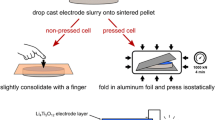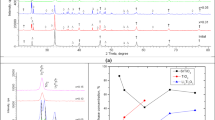Abstract
Different ceramic synthesis conditions of ramsdellite Li2Ti3O7 have been investigated in order to determine the influence on the electrochemical performances as the negative electrode of lithium-ion batteries. Lithium source, thermal pretreatment, synthesis temperature, and time of reactions were the analyzed conditions. A convenient and cheap reagent like Li2CO3 treated with TiO2 at high temperature (1250 °C) for very short time (2 h) provides a reliable active material. When tested versus lithium, the initial specific capacity (150 mAh g−1) is lower than that of ceramic samples prepared at lower temperature or for longer treatment times (ca. 170 mAh g−1). The lower initial capacity is attributed to the large particle size obtained at high temperature. However, advantageously the capacity retention of the former is superior. Thus, 115 mAh g−1 at C/20 rate is fairly kept (77 % retention) after 100 cycles. The better cyclability of samples prepared at high temperature (with large particle size) is likely due to lower surface reactivity that compensates the lower initial discharge capacity when cycling. A compromise between high initial capacity and capacity retention must be reached when using Li2Ti3O7 as a battery electrode. The good behavior of the optimized material is shown by testing it against commercial LiCoO2 as the positive electrode. The high capacity (ca. 135 mAh g−1) and outstanding cyclability observed prove that optimized ramsdellite may be effectively used as a long-life negative electrode material.









Similar content being viewed by others
References
Etacheri V, Marom R, Elazari R, Salitra G, Aurbach D (2011) Challenges in the development of advanced li-ion batteries. Energy Environ Sci 4(9):3243–3262. doi:10.1039/c1ee01598b
Yang ZG, Choi D, Kerisit S, Rosso KM, Wang DH, Zhang J, Graff G, Liu J (2009) Nanostructures and lithium electrochemical reactivity of lithium titanites and titanium oxides: a review. J Power Sources 192(2):588–598. doi:10.1016/j.jpowsour.2009.02.038
Ohzuku T, Ueda A, Yamamoto N (1995) Zero-strain insertion material of Li[Li1/3Ti5/3]O4 for rechargeable lithium cells. J Electrochem Soc 142(5):1431–1435. doi:10.1149/1.2048592
Zhu G-N, Wang Y-G, **a Y-Y (2012) Ti-based compounds as anode materials for li-ion batteries. Energy Environ Sci 5(5):6652–6667. doi:10.1039/c2ee03410g
Kyeremateng NA (2014) Self-organised TiO2 nanotubes for 2D or 3D li-ion microbatteries. Chemelectrochem 1(9):1442–1466. doi:10.1002/celc.201402109
Aravindan V, Lee Y-S, Madhavi S (2015) Research progress on negative electrodes for practical li-ion batteries: beyond carbonaceous anodes. Adv Energy Mater 5(13). Article: 1402225. doi:10.1002/aenm.201402225
Yoshio M, Wang HY, Fukuda K, Umeno T, Abe T, Ogumi Z (2004) Improvement of natural graphite as a lithium-ion battery anode material, from raw flake to carbon-coated sphere. J Mater Chem 14(11):1754–1758. doi:10.1039/b316702j
Park K-S, Benayad A, Kang D-J, Doo S-G (2008) Nitridation-driven conductive Li4Ti5O12 for lithium ion batteries. J Am Chem Soc 130(45):14930–14931. doi:10.1021/ja806104n
Yoshio M, Wang HY, Fukuda K (2003) Spherical carbon-coated natural graphite as a lithium-ion battery-anode material. Angew Chem Int Ed 42(35):4203–4206. doi:10.1002/anie.200351203
Yoshio M, Wang HY, Fukuda K, Hara Y, Adachi Y (2000) Effect of carbon coating on electrochemical performance of treated natural graphite as lithium-ion battery anode material. J Electrochem Soc 147(4):1245–1250. doi:10.1149/1.1393344
Aravindan V, Lee Y-S, Yazami R, Madhavi S (2015) TiO2 polymorphs in ‘rocking-chair’ li-ion batteries. Mater Today 18(6):345–351. doi:10.1016/j.mattod.2015.02.015
Zachauchristiansen B, West K, Jacobsen T, Atlung S (1988) Lithium insertion in different TiO2 modifications. Solid State Ion 28:1176–1182. doi:10.1016/0167-2738(88)90352-9
Ohzuku T, Kodama T, Hirai T (1985) Electrochemistry of anatase titanium-dioxide in lithium nonaqueous cells. J Power Sources 14(1–3):153–166. doi:10.1016/0378-7753(85)88026-5
Brohan L, Marchand R (1983) Physical properties of bronze MxTiO2(B). Solid State Ion 9–10:419–424
Gutierrez-Florez MT, Kuhn A, Garcia-Alvarado F (1999) Lithium intercalation in KxTi8O16 compounds. Int J Inorg Mater 1(1):117–121
Garcia-Alvarado F, de Dompablo M, Moran E, Gutierrez MT, Kuhn A, Varez A (1999) New electrode materials for lithium rechargeable batteries. J Power Sources 82:85–89
Kuhn A, Amandi R, Garcia-Alvarado F (2001) Electrochemical lithium insertion in TiO2 with the ramsdellite structure. J Power Sources 92(1–2):221–227
Kim C, Buonsanti R, Yaylian R, Milliron DJ, Cabana J (2013) Carbon-free TiO2 battery electrodes enabled by morphological control at the nanoscale. Adv Energy Mater 3(10):1286–1291. doi:10.1002/aenm.201300264
Cozzoli PD, Kornowski A, Weller H (2003) Low-temperature synthesis of soluble and processable organic-capped anatase TiO2 nanorods. J Am Chem Soc 125(47):14539–14548. doi:10.1021/ja036505h
Buonsanti R, Pick TE, Krins N, Richardson TJ, Helms BA, Milliron DJ (2012) Assembly of ligand-stripped nanocrystals into precisely controlled mesoporous architectures. Nano Lett 12(7):3872–3877. doi:10.1021/nl302206s
Dinh C-T, Nguyen T-D, Kleitz F, Do T-O (2009) Shape-controlled synthesis of highly crystalline titania nanocrystals. ACS Nano 3(11):3737–3743. doi:10.1021/nn900940p
Myung S-T, Kikuchi M, Yoon CS, Yashiro H, Kim S-J, Sun Y-K, Scrosati B (2013) Black anatase titania enabling ultra high cycling rates for rechargeable lithium batteries. Energy Environ Sci 6(9):2609–2614. doi:10.1039/c3ee41960f
Ren Y, Liu Z, Pourpoint F, Armstrong AR, Grey CP, Bruce PG (2012) Nanoparticulate TiO2(B): an anode for lithium-ion batteries. Angew Chem Int Ed 51(9):2164–2167. doi:10.1002/anie.201108300
Armstrong AR, Armstrong G, Canales J, Garcia R, Bruce PG (2005) Lithium-ion intercalation into TiO2-B nanowires. Adv Mater 17(7):862–875. doi:10.1002/adma.200400795
Armstrong AR, Armstrong G, Canales J, Bruce PG (2005) TiO2-B nanowires as negative electrodes for rechargeable lithium batteries. J Power Sources 146(1–2):501–506. doi:10.1016/j.jpowsour.2005.03.057
Armstrong AR, Armstrong G, Canales J, Bruce PG (2004) TiO2-B nanowires. Angew Chem Int Ed 43(17):2286–2288. doi:10.1002/anie.200353571
Inaba M, Oba Y, Niina F, Murota Y, Ogino Y, Tasaka A, Hirota K (2009) TiO2(B) as a promising high potential negative electrode for large-size lithium-ion batteries. J Power Sources 189(1):580–584. doi:10.1016/j.jpowsour.2008.10.001
Saito M, Murota Y, Takagi M, Tajima M, Asao T, Inoue H, Tasaka A, Inaba M (2012) Improvement of the reversible capacity of TiO2(B) high potential negative electrode. J Electrochem Soc 159(1):A49–A54. doi:10.1149/2.051201jes
de Dompablo M, Moran E, Varez A, GarciaAlvarado F (1997) Electrochemical lithium intercalation in Li2Ti3O7-ramsdellite structure. Mater Res Bull 32(8):993–1001
Pérez-Flores JC, Kuhn A, García-Alvarado F (2011) Synthesis, structure and electrochemical li insertion behaviour of Li2Ti6O13 with the Na2Ti6O13 tunnel-structure. J Power Sources 196(3):1378–1385. doi:10.1016/j.jpowsour.2010.08.106
Dominko R, Baudrin E, Umek P, Arcon D, Gaberscek M, Jamnik J (2006) Reversible lithium insertion into Na2Ti6O13 structure. Electrochem Commun 8(4):673–677
de Dompablo M, Varez A, Garcia-Alvarado F (2000) Structural study of electrochemically obtained Li2+xTi3O7. J Solid State Chem 153(1):132–139
Tsubone D, Hosoda T, Igarashi K, Shimizu T (1994) Synthesis and Thermal Expansion of Lithium Trititanate with Ramsdellite Type-Structure. Nippon Seramikkusu Kyokai Gakujutsu Ronbunshi. J Ceram Soc Japan 102(6):541–545
Izquierdo G, West AR (1980) Phase equilibria in the system Li2O-TiO2. Mater Res Bull 15(11):1655–1660
Abrahams I, Bruce PG, David WIF, West AR (1989) Refinement of the lithium distribution in Li2Ti3O7 using high-resolution powder neutron diffraction. J Solid State Chem 78(1):170–177. doi:10.1016/0022-4596(89)90141-2
Chen CJ, Greenblatt M (1985) Lithium insertion into Li2Ti3O7. Mater Res Bull 20(11):1347–1352
Garnier S, Bohnke C, Bohnke O, Fourquet JL (1996) Electrochemical intercalation of lithium into the ramsdellite-type structure of Li2Ti3O7. Solid State Ion 83(3–4):323–332. doi:10.1016/0167-2738(96)00002-1
Bohnke C, Fourquet JL, Randrianantoandro N, Brousse T, Crosnier O (2002) Electrochemical insertion of lithium into the ramsdellite-type oxide Li2Ti3O7: influence of the Li2Ti3O7 particle size. J Solid State Electrochem 6(6):403–411. doi:10.1007/s100080100243
Cho W, Kashiwagi T, Ra W, Nakayama M, Wakihara M, Kobayashi Y, Miyashiro H (2009) Relationship between electrochemical behavior and Li/vacancy arrangement in ramsdellite type Li2+xTi3O7. Electrochim Acta 54(6):1842–1850. doi:10.1016/j.electacta.2008.10.021
Cho W, Park MS, Kim JH, Kim YJ (2012) Interfacial reaction between electrode and electrolyte for a ramsdellite type Li2+xTi3O7 anode material during lithium insertion. Electrochim Acta 63:263–268. doi:10.1016/j.electacta.2011.12.093
Chen F, Li RG, Hou M, Liu L, Wang R, Deng ZH (2005) Preparation and characterization of ramsdellite Li2Ti3O7 as an anode material for asymmetric supercapacitors. Electrochim Acta 51(1):61–65. doi:10.1016/j.electacta.2005.03.047
Ogihara T, Kodera T (2013) Synthesis of Li2Ti3O7 anode materials by ultrasonic spray pyrolysis and their electrochemical properties. Materials 6(6):2285–2294. doi:10.3390/ma6062285
Rietveld HM (1969) A profile refinement method for nuclear and magnetic structures. J Appl Crystallogr 2:65–71
Rodriguez Carvajal J (1993) Recent advances in magnetic-structure determination by neutron powder diffraction. Physica B 192(1–2):55–69
Sears VF (1992) Neutron scattering lengths and cross sections. Neutron News 3:29–37
Momma K, Izumi F (2011) VESTA 3 for three-dimensional visualization of crystal, volumetric and morphology data. J Appl Crystallogr 44:1272–1276. doi:10.1107/s0021889811038970
Orera A, Azcondo MT, Garcia-Alvarado F, Sanz J, Sobrados I, Rodriguez-Carvajal J, Amador U (2009) Insight into ramsdellite Li2Ti3O7 and its proton-exchange derivative. Inorg Chem 48(16):7659–7666
Morosin B, Mikkelsen JC (1979) Crystal-structure of the Li + Ion conductor dilithium trititanate, Li2ti3o7. Acta Crystallogr Sect B 35(APR):798–800
Gover RKB, Irvine JTS, Finch AA (1997) Transformation of LiTi2O4 from spinel to ramsdellite on heating. J Solid State Chem 132(2):382–388
Gover RKB, Irvine JTS (1998) A new solid solution series linking LiTi2O4 and Li2Ti3O7 ramsdellites: a combined X-ray and neutron study. J Solid State Chem 141(2):365–372. doi:10.1006/jssc.1998.7948
He Y-B, Li B, Liu M, Zhang C, Lv W, Yang C, Li J, Du H, Zhang B, Yang Q-H, Kim J-K, Kang F (2012) Gassing in Li4Ti5O12-based batteries and its remedy. Sci Rep 2. Article number: 913. http://www.nature.com/srep/2012/121203/srep00913/abs/srep00913.html#supplementary-information
Reimers JN, Dahn JR (1992) Electrochemical and insitu x-ray-diffraction studies of lithium intercalation in LiXCoO2. J Electrochem Soc 139(8):2091–2097. doi:10.1149/1.2221184
Ohzuku T, Ueda A (1994) Solid-state redox reactions of LiCoO2 (R(3)OVER-BAR-M) for 4 volt secondary lithium cells. J Electrochem Soc 141(11):2972–2977. doi:10.1149/1.2059267
Zou MJ, Yoshio M, Gopukumar S, Yamaki J (2004) Synthesis and electrochemical performance of high voltage cycling (LiMCoO2)-Co-0.05-O-0.95 as cathode material for lithium rechargeable cells. Electrochem Solid State Lett 7(7):A176–A179
Amatucci GG, Tarascon JM, Klein LC (1996) CoO2, the end member of the LixCoO2 solid solution. J Electrochem Soc 143(3):1114–1123. doi:10.1149/1.1836594
Acknowledgements
We thank Airbus Defence and Space and EADS-CASA for funding this research on new rocking chair batteries and Brazilian Air Forces for making possible the stay of P. C. Miscow Ferreira at San Pablo CEU University. We thank Ministerio de Economía y Competitividad and Comunidad de Madrid for the projects MAT2013-46452-C4-1-R and S2013/MIT-2753, respectively. Support from Universidad San Pablo and in particular the cooperation of International Project Office is also acknowledged.
Funding
This study was funded by Ministerio de Economía y Competitividad (Grant number MAT2013-46452-C4-1-R), Comunidad de Madrid (Grant number S2013/MIT-2753 X), and Airbus Defence and Space.
Author information
Authors and Affiliations
Corresponding author
Ethics declarations
Conflict of Interest
The authors declare that they have no conflict of interest.
Rights and permissions
About this article
Cite this article
Díaz-Carrasco, P., Miscow Ferreira, P.C., Dolotko, O. et al. The effect of ceramic synthesis conditions on the electrochemical properties of Li2Ti3O7 . J Mater Sci 51, 4520–4529 (2016). https://doi.org/10.1007/s10853-016-9764-3
Received:
Accepted:
Published:
Issue Date:
DOI: https://doi.org/10.1007/s10853-016-9764-3




